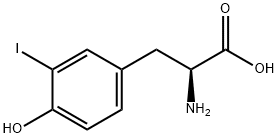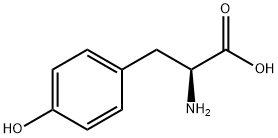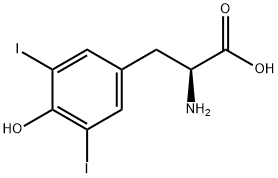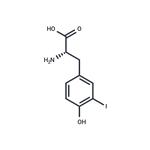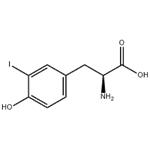Chemical Properties
White Solid
Uses
3-Iodo-L-tyrosine has been used as an inhibitor for tyrosine hydroxylase enzyme in
Drosophila and silkworm pupae.
Uses
A novel flavoprotein responsible for iodide salvage in thyroid glands. A tyrosine hydroxylase inhibitor.
Uses
3-iodo-l-tyrosine is used in the inhibition of tyrosine hydroxylase. 3-iodo-L-tyrosine is used in the rapid induction of prolactin secretion.
Definition
ChEBI: The monoiodotyrosine that is L-tyrosine carrying an iodo-substituent at position C-3 of the benzyl group.
General Description
Iodotyrosine coupled with di-iodotyrosine results in the synthesis of 3,5,3′-tri-iodothyronine (T3) or 3,3′,5′-tri-iodothyronine (rT3).
Biochem/physiol Actions
3-iodotyrosine (3-IY) inhibits tyrosine hydroxylase that catalyzes levodopa (L-DOPA) formation from tyrosine. Iodotyrosine deiodinase enzyme deficiency leads to elevated levels of 3-IY in serum and urine in severe hypothyroidism and goiter.
Purification Methods
Likely impurities are tyrosine, diiodotyrosine and iodide. Crystallise it by dissolving it in concentrated ammonia (~200mg in ~20mL), evaporate to ~5mL and NH4Cl is added to pH4.5—5.0. After a few hours at 0o, the amino acid crystallises in needles. It is filtered off, washed with a little ice-cold H2O and dried in a vacuum. Alternatively dissolve it in dilute ammonia at room temperature, then add dilute acetic acid to pH 6. Store it at 0o. Recrystallisation of ~250mg from H2O (~5mL) removes any diiodotyrosine. It is an inhibitor of tyrosine hydroxylase with a Ki of ~500nM. [Harrington & Rivers Biochem J 38 320 1944, Rivers Chem & Ind (London) 21 1956, Beilstein 14 III 1562, 14 IV 1562.]
